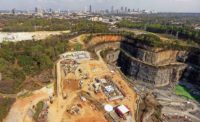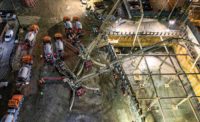Owners continue to seek greater efficiency, less risk and tighter schedules. This is driving more of them than ever before to explore such project delivery methods as construction management-at-risk (CMAR), design-build and integrated project delivery. As a result, these project delivery methods are growing rapidly and are quickly replacing the traditional design-bid-build method as the go-to means of executing projects.
The growth in alternative project delivery can be seen in the this year’s rankings of ENR’s Top 100 Construction Management-at-Risk Firms and Top 100 Design-Build Firms. The Top 100 CMAR firms had a combined revenue of $143.05 billion in 2018, up 8.2% from the $132.24 billion reported in 2017.
“What we’re finding is it’s not always easy to build the right teams for those [design-build] project types.”
– Ryan Heeter, COO of GE Johnson Construction Co.
What is more interesting in the Top 100 CMAR, revenue numbers for domestic projects rose 9.6%, to $133.30 billion, in 2018 over 2017 figures. This more than makes up for the 8.5% drop in revenue from international CMAR projects, which fell to $9.75 billion in 2018 from $10.66 billion in 2017.
The design-build list provides a similar contrast between domestic and international project delivery. Overall, the Top 100 design-build firms had a total revenue of $107.66 billion in 2018, up 4.3% from 2017. However, revenue from domestic design-build projects grew a more healthy 5.9%, rising to $85.20 billion, in 2018. On the other hand, international design-build revenue dropped 1.5% in 2018, thanks in part to a fall-off in huge engineering-procurement-construction projects in the international mining, power and petroleum markets.
To put the strong growth in design-build and CMAR in a broader context, domestic design-build revenue has grown 69.6% from 2010, when the construction recession ended, to 2018. This rise comes despite a dramatic drop in big-ticket engineer-procure-construction projects in the oil-and-gas, power and mining sectors. In the same time period, domestic CMAR revenue has grown 108.4%.
What used to be considered alternative forms of project delivery “are becoming increasingly commonplace—to the point that they’re not really alternative anymore,” says Scott Roux, senior vice president of Michael Baker International. “We are pursuing this work aggressively yet thoughtfully, and anticipate it comprising a larger percentage of our overall portfolio going forward.”
|
Related Links |
CMAR Is Surging
The market for CMAR has better than doubled in the past eight years for many reasons, as owners seek teamwork and earlier involvement in the design process than is typical in the traditional design-bid-build process. Many owners also have returned to CMAR after some bad experiences during the industry recession of 2008-10, when owners thought they could get cut-rate pricing using design-bid-build.
“Design-build is hot and trending.”
– Lisa Washington, CEO of the Design-Build Institute of America
“During the downturn, many owners thought they would get the best price from design-bid-build, but that didn’t always work out that well,” says Dennis Cornick, executive vice president of Gilbane Building Co. So CMAR is returning to be the go-to project delivery method in the buildings sector.
CMAR also is making major strides in the public infrastructure market, particularly in the water and wastewater sector. For example, Clark Construction Group’s subsidiary Atkinson Construction is helping the City of Atlanta bolster its clean water system with the Atlanta Water Supply, Bellwood Quarry Tunnels and Shaft project, says Chip Hastie, executive vice president of Clark. Atkinson’s Underground Division has been working on the CMAR project over the last three years, constructing a water tunnel.
Design-Build Is Trending
Design-build also is rapidly expanding as the project delivery method of choice for many market sectors. “Design-build is hot and trending,” says Lisa Washington, CEO of the Design-Build Institute of America, Washington, D.C.
Washington points to two studies from last year that show both the growth and effectiveness of design-build. In June 2018, a joint study by DBIA and Raleigh, N.C.-based industry consultant FMI Corp. found that design-build is expected to grow 18% from 2018 to 2021 and will make up 44% of the nonresidential market by 2021.
The DBIA-FMI study was followed in November by a study of project-delivery performance by the Construction Industry Institute, an Austin, Texas-based industry research organization, and the Pankow Foundation, a McLean, Va.-based research group. The study of 212 projects found that design-build was the best performing project delivery method, 61% faster than CMAR and 102% faster than design-bid-build.
“We had plenty of anecdotal evidence that design-build was faster and cheaper than other project delivery methods, but these studies give us solid facts to support that claim,” says Washington.
Design-build opportunities are growing for a variety of reasons. “Speed to market is one of the drivers for the increase in design-build market,” says Cornick of Gilbane. “Plus, there is only one neck to choke at the end of the day.”
Owners are becoming more familiar and comfortable with having a single unified contracting entity for design and construction, which can result in better collaboration, compressed schedules and lower capital cost. “However, it is not just owners that are utilizing this delivery method. Many subcontracted trades are employing design-build contracts as well,” says Dan McCreary, principal of the Dennis Group.
Clearly, clients are more willing than in the past to require early contractor involvement on their projects. “Integrated delivery methods such as CMAR and progressive design-build heighten collaboration during the early stages of project development and decrease iterations needed to finalize the building program and design,” says Hastie of Clark Construction. He says that as much as two-thirds of Clark’s current pipeline of work is forecast to utilize some form of early-involvement delivery method.
A Progressive Idea
A variation of design-build has suddenly become a hot trend: progressive design-build. In progressive design-build, a design-build team signs a single contract and works with the client through the early design process, but only establishes a guaranteed maximum price once the design is more clearly defined. This gives the client a much more active role in the design process.
“Progressive design-build has created so much interest that we sold out our first two conferences on it and our third conference is almost sold out,” says Washington of DBIA. The group now is working on a fourth conference to answer the demand for training.
Washington state has become the first state to authorize the use of progressive design-build for public agencies. “Public buyers such as the University of Washington have moved to progressive design-build, where teams are selected based on qualifications and approach, and design doesn’t start until the client is in the room,” says Bart Ricketts, CEO of Lease Crutcher Lewis. The firm is building the UW Population Health Facility and will build the Health Sciences Education Facility on campus, using progressive design-build, he says.
“There’s the inevitable discussion of division of risk. It’s compelling to consider fully integrated forms of delivery in this environment because, otherwise, unequal division of risk can erode the advantages of design-build.”
– George Pfeffer, DPR Construction, management committee member
However, many firms caution that design-build is not an instant solution for project delivery. Designers and contractors must be able to work well with each other and iron out the terms and conditions of the contract early. “The duration between design completion and construction is gone,” says George Pfeffer. DPR Construction’s management committee member.
Further, as contractors are bringing design expertise in-house to help and as designers are trying to improve their construction knowledge, “there’s the inevitable discussion of division of risk. It’s compelling to consider fully integrated forms of delivery in this environment because, otherwise, unequal division of risk can erode the advantages of design-build,” says Pfeffer.
Firms are being cautious about selecting their teams. “What we’re finding is it’s not always easy to build the right teams for those project types. Teams that can perform well in those types of environments will be in higher and higher demand as project owners demand more and more value,” says Ryan Heeter, COO of GE Johnson Construction Co.
One area of concern in project delivery is the increasing use of public-private partnerships. As infrastructure funding becomes more precarious and state and local needs rise, states increasingly are passing P3 enabling legislation (see chart above).
However, with P3s, designers and contractors often see little of the ultimate users—the public agencies—and must now deal with the financial entities paying for, and hoping to profit from, the project. “P3s require a whole different mindset,” says Cornick of Gilbane. He says that in a normal project scenario, firms deal directly with the owner. But in a P3 project, firms often have to base their decisions on costs, rather than on what might be better for the project. “We are used to dealing with directors of construction, but in P3s, you deal more with financial people instead,” he says.
Nonetheless, P3s are no longer a rarity. “The interest in the P3 market is increasing. However there is a learning curve for owners to understand within that market,” says Deron Brown, President of US Operations for PCL Construction. He notes that PCL is a member of the LA Gateway Partners P3 consortium building the Consolidated Rent-A-Car (ConRAC) facility at the Los Angeles International Airport.
The market is looking for ways of reducing risk from cost to delivery to operation, which is why CMAR, design-build and P3 project delivery methods are gaining traction. However, “the question for the adopters of these new models will be whether they are truly getting the most value for their money, or simply reducing risk,” says Ted Hyman, managing partner of ZGF Architects. “There are profound implications that are inherent in any delivery method and the client must understand those before deciding which approach is best suited for the project and their own institution’s culture,” he says.





Post a comment to this article
Report Abusive Comment